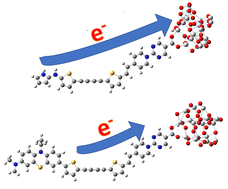Charge transfer properties of novel linear carbon chain-based dyes†
Abstract
In this study, we designed a series of dyes based on the D–π–A scheme, featuring the novel 2-amino pyrrole group, D1, as the donor unit, combined with three different acceptor groups: benzothiadiazole (A2), cyanoacrilic acid, (A3), and a unique pyrimidin-pyridinium salt derivative, A1, not previously employed in DSSC applications. A linear carbon chain (LCC) of varying lengths was used as the π-bridge. We compared the performance of D1 dyes with the well-established electron donor phenothiazine, D2. Spectroscopic, electronic and photochemical properties of these designed compounds were investigated through density functional theory (DFT) and time-dependent density functional theory (TDDFT) simulations. The calculated light-harvesting efficiency (LHE) values showed that A1 yielded the best results, and generally, D1 donors outperformed the reference D2. Additionally, longer LCCs contributed positively to LHE. The study of electron density difference (EDD) maps showed clear charge transfer from the donor unit to the acceptor unit in all cases. Dyes with D1 exhibited lower intramolecular reorganization energy (λi) values, indicating faster charge transfer compared to those with D2. Negative free energy injection values (ΔGinj) were calculated for all sensitizers, signifying efficient electron injection, especially in D2-containing dyes. However, these compounds exhibited positive free energy regeneration values (ΔGreg), implying thermodynamically unfavorable regeneration processes. Conversely, D1-containing compounds demonstrated favorable values for regeneration. Increasing the length of the LCC positively affected ΔGreg but had a less favorable impact on ΔGinj. The calculated charge transfer (qCT) values revealed that the most favorable results occurred when pairing the donor with A1, indicating that this acceptor group promoted charge separation. Simulations of dye@(TiO2)14 anatase complexes indicated that the binding of the designed dyes to the semiconductor improved their transport properties. In summary, all the calculated parameters indicated that D1 possesses superior properties for use in DSSC applications when coupled to A1 and, generally, dyes featuring D1 were predicted to perform well in photovoltaic applications. It is worth noting that ΔGreg values may hinder regeneration in D2-containing dyes, despite their excellent values in other calculated parameters. Our study offers valuable insights for refining dye design in order to boost the performance of dye-sensitized solar cells (DSSCs).

- This article is part of the themed collections: 2024 Journal of Materials Chemistry C HOT Papers and Molecular scale electronics


 Please wait while we load your content...
Please wait while we load your content...